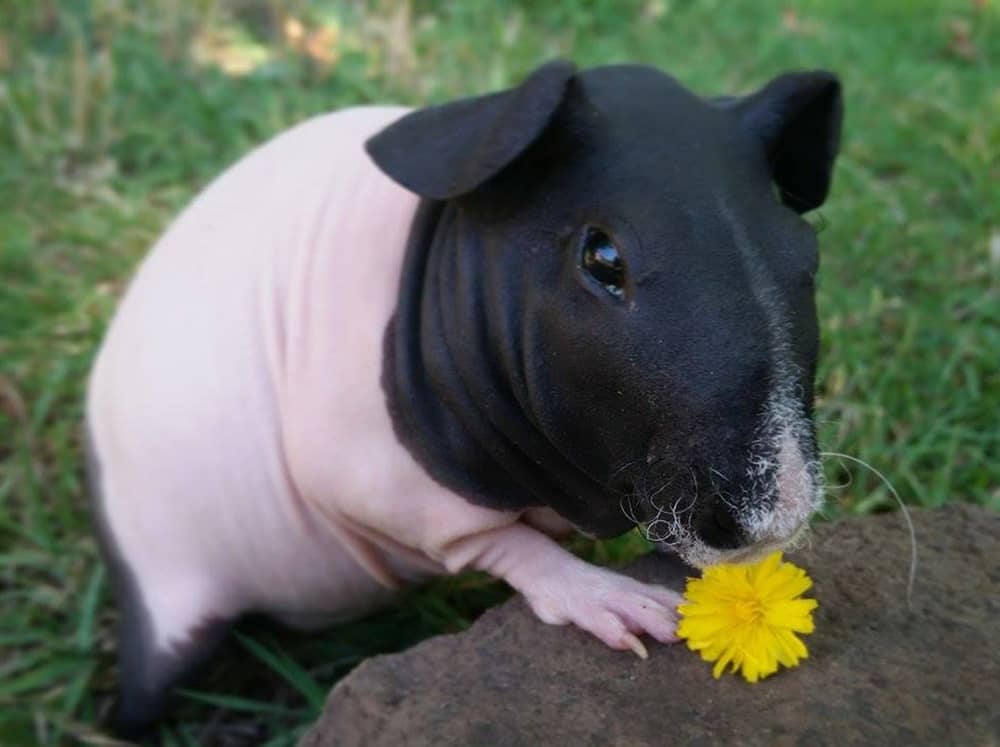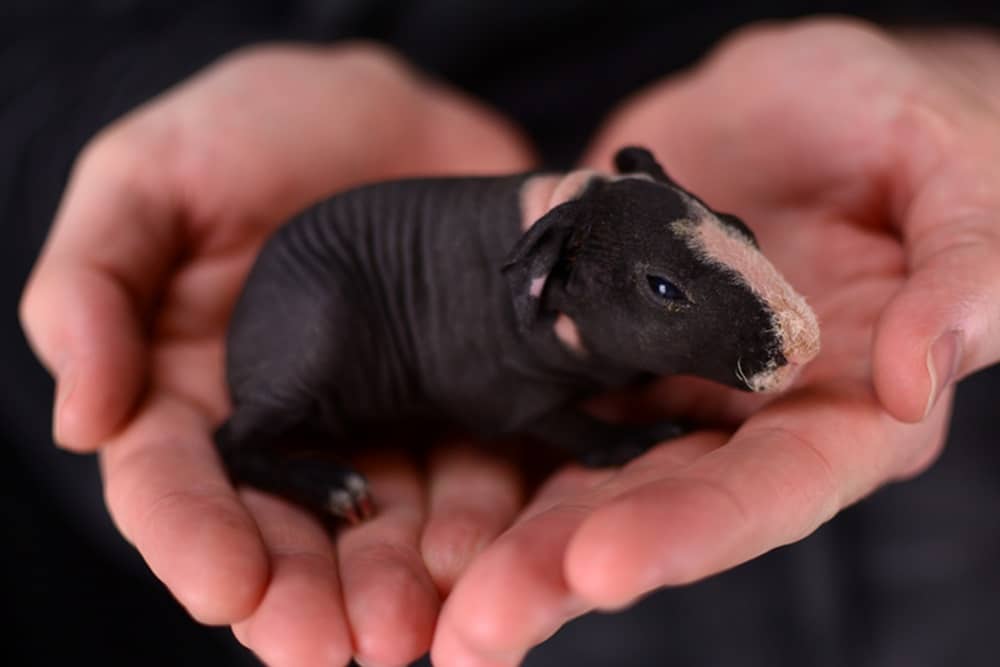The Skinny Pigs, also known as hairless, are one of the hairless strains of guinea pig. There are two types of hairless pigs; one is the skinny pigs that have some hairs on their back, feet, muzzles, and legs, while the other one is the Baldwin, as the name suggests, they do not have hairs on their body. The skinny pig is very soft and born without much hair. They come in different patterns and colors, like “Dutch”, “Brindle”, and “Himalayan.”

Skinny pigs are a breed of Guinea pigs that were developed through selective breeding. They originated from a laboratory setting in the 1970s, specifically from a strain of Guinea pigs bred. This breed emerged when a genetic mutation resulted in hairless Guinea pigs, which scientists initially used for skin research due to their lack of fur. Over time, these hairless guinea pigs were introduced to the pet market, where they gained popularity due to their unique appearance and affectionate nature.
Although skinny pigs were initially bred in labs, they share the same origins as other guinea pig breeds of the Andes Mountains in South America, primarily from regions in Peru, Bolivia, and Argentina.
Skinny Pig Size
The size of a fully-grown skinny pig is between 8 and 10 inches (20-25 cm) in length. They are stout with cylindrical bodies and have short legs. Adult female skinny pigs weigh around 1.2 to 2.0 pounds (550 to 900 grams), and adult males weigh between 1.5 and 2.5 pounds (700 to 1,100 grams).
Skinny Pig Lifespan
The average lifespan of a skinny pig is around 5 to 7 years in captivity with proper care. Some may live up to 8 years or more.
Behavior and Temperament of Skinny Pigs
Despite being hairless, they are similar in behavior to other Guinea pig breeds. They are very social and friendly animals with humans as well as other guinea pigs. These small creatures are quite attached and enjoy interacting with their owners. They may seek attention by squeaking or nudging. Skinny pigs love being petted and can often be seen snuggling with their owners.
They love being with others; if they are kept alone, they feel loneliness. So you should make sure to give them enough companionship or have two guinea pigs.

Skinny Pigs are also playful and curious. They love exploring their environment, running around, and playing with toys. It’s important to give them plenty of space to move and enrich their habitat with tunnels, chew toys, and hideaways. They are very active, so they need stimulation to stay happy.
Moreover, unlike some other pets, they are very gentle and non-aggressive. They rarely bite or show signs of aggression unless frightened or stressed. When properly socialized, they are calm and easy to handle. Skinny pigs are quite vocal and communicate through a variety of sounds. They often make high-pitched squeaks or “wheeks” when excited, especially at feeding times.
Skinny pigs are very affectionate animals but also very sensitive to their environment. They may become stressed in loud or chaotic environments, so it is essential to provide them with a calm, quiet space to feel safe.
How to Care for a Skinny Pig?
To care for a skinny pig is a big responsibility. You have to take care of their health, diet, cage, and natural habitat.
Skinny Pig Food
Skinny pig food or diet is similar to other guinea pigs. A balanced and full-of-nutrient diet is crucial to their health and well-being. Due to their lack of fur, skinny pigs have a higher metabolism, which means they need more food to maintain their energy levels than other-haired breeds. Here are some skinny pig foods that you need to take care of:
Hay
Hay is the primary stable for skinny pigs. You should ensure that hay is available to a skinny pig’s diet 24/7 because it provides the essential fiber they need to maintain healthy digestion and keep their teeth trimmed. You can offer timothy hay, orchard grass, or meadow hay. Hay is very helpful for them as it prevents digestive problems like bloating.
Fresh Vegetables
Fresh vegetables are an essential part of a skinny pig’s diet as they are rich in vitamins and nutrients, especially vitamin C, which is crucial for their health. It is better to provide them with enough vitamin C, as they are not able to produce their vitamin C.
You should include some vitamin C-rich vegetables like kale, spinach, parsley, and broccoli; some leafy greens like Dandelion greens, turnip greens, and Romaine lettuce; and some other veggies like carrots, chickweed, zucchini, cucumber, and clover in your skinny pig diet. You should offer about 1 cup of fresh vegetables per day, with some leafy greens and vitamin C-rich options.
Pellets: Fortified with Vitamin C
You can offer high-quality, commercially available Guinea pig pellets to your skinny pigs. It helps to keep your pigs healthy and free from health issues. You should make sure the pellets are fortified with vitamin C, as this nutrient is crucial for preventing health issues like scurvy. You can offer 1/8 to 1/4 cup of pellets per day.
Also, be careful to provide only pellets formulated specifically for guinea pigs because other pellets may not have all the necessary nutrients. Avoid pellets with added seeds, nuts, or sugary ingredients, as these can be unhealthy for your skinny pig. You should ensure that the pellets are fresh.
Fresh Fruits
You can treat your skinny pigs with some fresh fruits also but they should only be offered occasionally due to their high sugar content. Don’t forget to include apples, bananas, berries like strawberries, blackberries, raspberries, or cranberries; pears, papaya, and watermelon in their diet. You can give fruits in a small portion with their diet or give them sparingly. You should offer fruits no more than 1-2 times per week as a special treat for them.

Access to Fresh Water
Skinny pigs need constant access to fresh, clean water. A water bottle with a spout designed for small animals is ideal, as it helps keep the water clean and prevents spills. You should change the water daily to ensure it stays clean and free of debris.
Vitamin C Supplements
As skinny pigs are prone to vitamin C deficiency, you can choose to supplement their diet with vitamin C drops or tablets. However, it is better to provide vitamin C through natural sources like vegetables, as supplements in water can degrade quickly and may affect the taste of the water. But if necessary, you can offer them some vitamin C supplements. Also, you can consult with a veterinarian before adding supplements to ensure it’s necessary.
Foods to Avoid
- Commercial pellets containing seeds and nuts
- Animal by-products or dairy products
- Foods with added preservatives and artificial flavors and colors
- Corn products
- Onions and garlic
- Gas-producing vegetables like cabbage, cauliflower, and beans.
- Iceberg lettuce
- Human foods that are high in fat, salt, or sugar
Skinny Guinea Pig Cage
Skinny pig cages should be large enough to explore. Because of their high metabolism, they are more energetic than other guinea pigs and need more space to thrive. The cage should be escape-proof and do not have sharp edges. The floor of the cage should be soft, as hard or wire flooring can hurt their sensitive feet.
You should keep their environment clean for a healthy life. Because of their lack of fur, they are more sensitive than any other breed and can feel the cold. So you need to ensure that they should be kept at a perfect temperature. They can also feel overheating, so ensure to keep them at a room-range temperature between 18°C and 23°C. The minimum cage size should be 7.5 square feet for a single skinny pig. A cage size of at least 10.5 square feet should be ideal for two skinny pigs.
The cage for a skinny pig with a plastic bottom and a wire mesh top is ideal for easy cleaning and proper ventilation.
Specific Substrate Needs
As they lack fur, the bedding of skinny pigs should be soft, comfortable, and warm with non-irritating materials to prevent skin issues and provide insulation. You can use fleece or paper-based bedding for your skinny pigs. Paper bedding like Carefresh is soft, absorbent, and dust-free and should be used. Avoid using wood shavings like cedar or pine, as they contain oils that can cause respiratory problems.
Skinny pigs love having places to hide and explore, which also makes them feel safe and secure. You can add hideouts, tunnels, and cozy fleece beds to their enclosure to provide warmth and security. As they are prone to getting cold, you can add a small pet-safe heating pad under part of the bedding or use fleece bedding. As they are very intelligent and curious animals, you can include some toys like tunnels, balls, or wooden chew toys for their physical and mental stimulation.
Cleaning Skinny Pig Cage
You should keep the cage and bedding clean and remove soiled bedding, uneaten food, and waste daily to prevent odors and bacterial growth. You should ensure fresh hay and clean water are always available. Once a week, you can remove all bedding, clean the cage thoroughly with pet-safe cleaning products, and replace the bedding with fresh material.
Handling a Skinny Pig
Skinny pigs are very sensitive and curious animals, and they love being with humans and cuddling them. But you need to make sure that your skinny pig is feeling comfortable first before cuddling.
They take time to adjust to the environment with humans and other guinea pigs. You should always use a soft and gentle voice around them and not shout at them. You should avoid sudden movements as it can scare them, which makes them nervous.

Moreover, when you are picking up a skinny pig, ensure they are in the mood to play and lift them slowly and securely with one hand under the chest and the other one under the hindquarters. Do not squeeze or hold them tightly. Let them play with you outside the cage, but always supervise them. Give them time to feel adjusted to you and the environment. Always clean and warm up your hands before picking them up to avoid any health issues and shocking them with cold hands.
Exercise
You can create a safe space with barriers or a playpen outside the cage where they can roam freely. This gives them room to run, explore, and engage in natural behaviors. You can give them some wooden toys or cardboard items for chewing, which helps keep their teeth healthy while keeping them active. Provide them with some toys, as they love pushing small, lightweight balls. Also, you can add climbing ramps and platforms in their cage, which is an excellent way to exercise.
It is advisable to keep skinny pigs in pairs so that they can enjoy the company of each other.
Health Issues
Skinny pigs can have various health issues, like all Guinea pigs. Due to a lack of fur, they are more prone to some health problems because of their sensitive skin. You should know the common health issues and their symptoms so that you can detect them and provide vet care.
- Skin problems are very common in skinny pigs, as their skin is sensitive to environmental factors. They can have dry skin due to their constant exposure to the air. You can notice signs like flaky patches, redness, and itchiness. So you need to moisturize their skin with vet-recommended creams. The bare skin of skinny pigs is more susceptible to fungal infections, such as ringworm, which thrive in moist, humid conditions. You should ensure hygiene in cages and avoid damp environments. Skinny pigs can also be affected by mites or lice, which may cause itching, redness, or scabs on their skin.
- Skinny pigs are very Sensitive to Temperature. They cannot regulate their body temperature as other guinea pigs can. This may result in overheating or hypothermia (getting too cold). Heavy breathing, lethargy, drooling, shivering, weakness, and curling up in a tight ball can be the symptoms of these temperature problems. So you need to be careful to give them the right temperature.
- Skinny pigs cannot produce their vitamin C; that’s why they are prone to vitamin C deficiency (scurvy). A lack of vitamin C can lead to severe health problems, including joint issues, gum disease, and lethargy.
- Respiratory infections are common in skinny pigs. These infections can be caused by bacteria, viruses, or poor living conditions, such as a dirty or damp cage. Sneezing, coughing, or labored breathing can be the symptoms.
- Skinny Pigs have continuously growing teeth, which can lead to dental problems if their teeth don’t wear down properly. Difficulty eating or dropping food from their mouth, weight loss, or misaligned teeth are the signs.
- Skinny pigs can suffer from various digestive issues, such as bloat or diarrhea, often due to an improper diet or stress. Swollen abdomen, reluctance to move, lack of appetite, loose, watery stool, and lethargy are symptoms.
- Skinny pigs can also become overweight if they are not getting enough exercise or are being overfed, particularly with treats or pellets.
Grooming
Grooming skinny pigs is very straightforward as compared to other guinea pigs since they don’t have fur. But their hairlessness makes their skin more sensitive and prone to dryness, so you can moisturize your pet pigs with vet-recommended lotions or creams. Skinny pigs don’t need frequent baths.
However, you can give them occasional baths to keep their skin clean and healthy. You need to trim their nails regularly to prevent overgrowth. Skinny pigs may accumulate debris around their ears and eyes, which you need to clean regularly to prevent infections. Skinny pigs have a grease gland near the base of their spine, which can sometimes become clogged and dirty, so clean that area properly. Also, you can use potty-proof pads for your piggy.
Where to Buy?
If you want to bring these piggies to your home, you should know where you can buy them. Always look for reputable breeders who specialize in skinny pigs and can give healthy animals. You should ensure that they have been raised in good condition before buying. A thorough research is needed before buying them. You can also consider adopting from local animal shelters or rescue organizations, which often have guinea pigs, including skinny pigs. Moreover, many pet stores may carry skinny pigs, but always check the stores and pets and know about their care.
Upkeep Cost
The upkeep cost of a skinny pig can vary, but it is important to budget appropriately to ensure their health and happiness. You might spend between $50 and $200 on a spacious cage, with additional costs for bedding ranging from $10 to $30 per month. Aside from diet expenses, routine veterinary care is essential and can cost around $50 to $150 for annual check-ups. Overall, the monthly upkeep costs can range from $50 to $100 or more, depending on your choices and the needs of your skinny pigs.
Reproduction and Breeding
For breeding, both male and female skinny pigs need to stay healthy and well cared for before mating. Generally, female skinny pigs reach sexual maturity at around 4 to 6 months, while males can breed as early as 3 months. It is important for you to check their health, as skin issues or other health conditions can complicate pregnancy and care for the offspring.
The gestation period for skinny pigs is approximately 63 days, and females can give birth to a litter of 1 to 6 pups, which depends on their health and age. After giving birth, the mother should have a quiet, safe space to care for her young. It is advisable to consult a veterinarian with experience in small animals before breeding to ensure the health and well-being of both the parent pigs and the pups.
Pros and Cons of Keeping Skinny Pigs as Pets
| PROS | CONS |
| They are social creatures and love to bond with others. | Maintaining their cage is a big responsibility and time-consuming task. |
| They do not have a complex diet. | They require large space. |
| It is easy to set their habitat. | You have to feed them regularly. |
| They are very curious animals, so they are fun to play with. | They are susceptible to temperature changes because of their sensitive skin. |
| Their size and gentle nature make them easy to handle and care for. | Upkeep costs can be high. |
| Skinny pigs require less grooming compared to other breeds. | Limited availability. |
Interesting Facts About Skinny Pigs
- Skinny pigs are a hybrid breed, originally developed from a cross between the American guinea pig and other hairless breeds.
- They are social animals and love to interact with their owners and other Guinea pigs.
- Skinny pigs may perform a behavior called “popcorning,” where they jump and twist in the air when they are happy and excited, showing a sign of their playful spirit.
- Skinny pigs communicate through various vocalizations, including wheezing, chirping, and purring, which express their emotions and needs.
- Skinny pigs come in a range of skin colors and patterns, just like other furred Guinea pigs.
- Skinny pigs are generally calm and quiet, making them suitable pets for families or individuals living in apartments or quieter environments.

A Skinny Pig vs. Other Guinea Pigs
| Feature | Skinny Pigs | Other Guinea Pigs |
| Fur Type | Hairless | Furred (various coat types and lengths) |
| Temperature Sensitivity | Highly sensitive, need warm environments | Less sensitive, can tolerate a range of temperatures |
| Skin Care | Requires regular moisturizing and skin checks | Minimal grooming is needed but may require brushing |
| Breeding | Can be bred easily but requires health monitoring | Generally bred with attention to coat and color traits |
| Vocalization | Communicate through a range of sounds | Similar vocalizations, but may differ in tone and frequency due to fur |
| Health Issues | More prone to skin issues and sunburn | Prone to dental and respiratory issues, but less skin-related concerns |
| Grooming Needs | Requires skin care; less grooming overall | Requires regular grooming depending on coat type |
| Dietary Needs | Similar dietary requirements (hay, pellets, veggies) | Same dietary needs, but some may need more specific diets based on fur type |
| Lifespan | Generally 5-7 years | Typically 4-6 years, but some can live longer |
| Social Needs | Highly social, thrives with companions | Also social; many enjoy living in groups or pairs |
| Behavior | Playful and curious, tend to be very interactive | Varies by breed, but many are friendly and enjoy interaction |
| Availability | Less common, may be harder to find | More widely available in pet stores and shelters |
Frequently Asked Questions
Question 1: Do skinny pigs need baths?
Answer: Skinny pigs generally do not require regular baths, as they can develop skin issues from excess moisture. However, occasional spot cleaning may be necessary if they get particularly dirty.
Question 2: Do skinny pigs stink?
Answer: Skinny pigs do not have a strong odor, but their living environment can smell if not cleaned regularly. Proper cage maintenance and hygiene will help minimize any unpleasant smells.
Question 3: Do skinny pigs need to be in pairs?
Answer: Skinny pigs are social animals and thrive in pairs or small groups. Keeping them with a companion helps prevent loneliness and encourages natural social behavior.
Question 4: Do skinny pigs need special care?
Answer: Skinny pigs require special care, particularly regarding their skin, which needs regular moisturizing. They also need a stable, warm environment and a diet rich in vitamin C.
Question 5: Do skinny pigs need sunlight?
Answer: Skinny pigs do not require direct sunlight but should be exposed to natural light for a few hours daily to support their overall health. Ensure they have shaded areas to retreat to if they feel too warm.
Question 6: Are skinny pigs hypoallergenic?
Answer: While no pet is entirely hypoallergenic, skinny pigs may produce fewer allergens compared to furry Guinea pigs because they lack fur. However, individuals with allergies should spend time around them to assess their reactions.
Question 7: Can skinny pigs be litter-trained?
Answer: While it is possible to litter train skinny pigs, it requires patience and consistency. Providing a designated area with appropriate bedding and encouraging them to use it can help, but not all guinea pigs will take it.
Conclusion
In conclusion, caring for Skinny Pigs requires dedication to fulfill their unique needs. They are more sensitive to temperature changes and prone to skin issues because of their hairless bodies. You should ensure to provide a warm, clean, and comfortable environment for them. Proper diet, regular grooming, and vet check-ups are also important to ensure they remain healthy and happy. While skinny pigs may require a bit more attention than their furry breeds, their affectionate personalities, and distinctive looks make them wonderful pets. By providing the right care and love, you can enjoy great companionship with these special guinea pigs.


